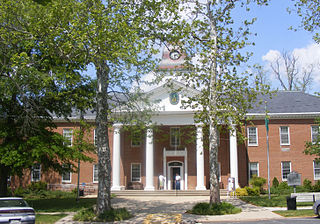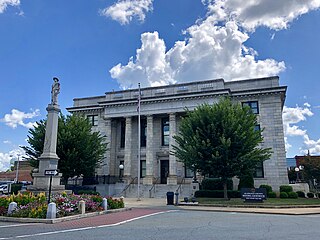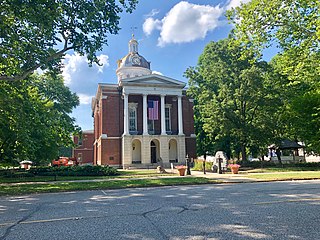
A courthouse or court house is a structure which houses judicial functions for a governmental entity such as a state, region, province, county, prefecture, regency, or similar governmental unit. A courthouse is home to one or more courtrooms, the enclosed space in which a judge presides over a court, and one or more chambers, the private offices of judges. Larger courthouses often also have space for offices of judicial support staff such as court clerks and deputy clerks.
A sheriff is a government official, with varying duties, existing in some countries with historical ties to England where the office originated. There is an analogous, although independently developed, office in Iceland that is commonly translated to English as sherif.

A bailiff is a manager, overseer or custodian – a legal officer to whom some degree of authority or jurisdiction is given. Bailiffs are of various kinds and their offices and duties vary greatly.
A hundred is an administrative division that is geographically part of a larger region. It was formerly used in England, Wales, some parts of the United States, Denmark, Southern Schleswig, Sweden, Finland, Norway, the Bishopric of Ösel–Wiek, Curonia, the Ukrainian state of the Cossack Hetmanate and in Cumberland County in the British Colony of New South Wales. It is still used in other places, including in Australia.

The King County Courthouse is the administrative building housing the judicial branch of King County, Washington's government. It is located in downtown Seattle, just north of Pioneer Square. The 1916 structure houses the King County Prosecuting Attorney, the King County Sheriff's Office (KCSO), the King County Council, the King County Law Library, King County Work and Education Release, and courtrooms for the King County Superior Court and the Seattle District Court. It is located just north of City Hall Park at 516 Third Avenue, between Dilling Way and James Street.
A court clerk is an officer of the court whose responsibilities include maintaining records of a court and administering oaths to witnesses, jurors, and grand jurors as well as performing some quasi-secretarial duties. The records management duties of a court clerk including the acceptance of documents for filing with the court to become part of the court's official records, and maintaining the docket, register of actions, and/or minutes of the court which list all filings and events in each case. These duties are important because the availability of legal relief often depends upon the timely filing of documents before applicable deadlines.

A courtroom is the enclosed space in which courts of law are held in front of a judge. A number of courtrooms, which may also be known as "courts", may be housed in a courthouse. In recent years, courtrooms have been equipped with audiovisual technology to permit everyone present to clearly hear testimony and see exhibits.

The Santa Barbara County Courthouse (Courthouse) is a well-known example of Spanish Colonial Revival architecture and is located in Santa Barbara, Santa Barbara County, California. Started in 1926 and completed in 1929, the Courthouse originally served as Santa Barbara County’s (County) superior courthouse, jail, and administrative office. The Courthouse was included on the National Register of Historic Places in 1981, was made a City of Santa Barbara Historic Landmark in 1982, a California Historical Landmark in 2004, and a National Historic Landmark in 2005. Over the years, most County administrative offices were relocated to other County buildings. The current Courthouse houses six County Superior Court rooms, the Mural Room, the County Hall of Records, the County Public Defender's Office, offices of the County General Services Department, and the McMahon Law Library. The Courthouse is open to the public and is a popular site for community gatherings and weddings. Architect Charles Willard Moore called it the "grandest Spanish Colonial Revival structure ever built," and the prime example of Santa Barbara's adoption of Spanish Colonial as its civic style.

The Caroline County Courthouse is located at 109 Market Street in Denton, Maryland. The courthouse houses the chambers and courtrooms for the judge of the Circuit Court for Caroline County, as well as the clerk's offices, jurors' assembly room, the Office of the State's Attorney for Caroline County, the Register of Wills and the master's office.

The Superior Court of Los Angeles County is the California Superior Court located in Los Angeles County. It is the largest single unified trial court in the United States.
The Alameda County Superior Court, officially the Superior Court of California, County of Alameda, is the California superior court with jurisdiction over Alameda County as established by Article VI of the Constitution of California. It functions as the trial court for both criminal and civil cases filed in Alameda County.

The Alamance County Courthouse in Graham, North Carolina, was built in 1923. It was listed on the National Register of Historic Places in 1979.

The E. Barrett Prettyman Federal Courthouse is a historic building in Washington, D.C. It was built in 1949–50 and currently houses the United States District Court for the District of Columbia, the United States Court of Appeals for the District of Columbia Circuit, and the United States Foreign Intelligence Surveillance Court.

The Historic Fairfax County Courthouse is one of the oldest buildings in Fairfax, Virginia. It was constructed in 1799 to serve as the seat of government in Fairfax County. During the American Civil War, the first Confederate officer casualty of the war took place on the courthouse grounds and the building was occupied by both sides in the conflict. Today, the original courthouse building is part of the larger courthouse site that serves the local government of Fairfax County.

The Old Ipswich Courthouse is a heritage-listed former courthouse located at 73–75 East Street, Ipswich, City of Ipswich, Queensland, Australia. It was designed by Charles Tiffin and built from 1859. It was added to the Queensland Heritage Register on 21 October 1992.

Gympie Lands Office is a heritage-listed former court house and public administration building at 26 Channon Street, Gympie, Queensland, Australia. It was designed by Queensland Department of Public Works and Queensland Colonial Architect's Office and built in 1942 by the Department of Public Works, Gympie City Council, Mark Doggett, Andrew Collins, and George Caldwell. It was added to the Queensland Heritage Register on 15 July 2011.

Croydon Court House is a heritage-listed former courthouse at Samwell Street, Croydon, Shire of Croydon, Queensland, Australia. It was designed by Colonial Architect's Office and built in 1887. It was added to the Queensland Heritage Register on 21 October 1992.

Tambo Court House is a heritage-listed former courthouse and now library at 9 Arthur Street, Tambo, Blackall-Tambo Region, Queensland, Australia. It was built from 1887 to 1897. It is also known as Tambo Shire Council Library. It was added to the Queensland Heritage Register on 21 October 1992.

The Shire Hall is a municipal structure in Broad Street, Presteigne, Powys, Wales. The building incorporates a well-preserved courtroom and a museum known as "the Judge's Lodging". Once the judicial centre for Radnorshire, is a Grade II* listed building.

Nineteenth-century American county courthouse architecture was used in buildings designed to house judicial and administrative functions in styles such as Federal, Neoclassical, Italianate, Second Empire, and Romanesque Revival, which were adapted to local building materials and styles to accommodate local needs. Over the course of the nineteenth century, the typical American county courthouse became more specialized than its eighteenth century predecessor, featuring increased usage of interior passageways and multiple levels and stairwells to facilitate a greater level of formality to court proceedings than could often be achieved through earlier examples which were centered around a single room on the ground floor. The gradual replacement of courtroom fittings associated with the English common law with those associated with American adversarial statute law, along with the use of clock towers, statuary, turrets, domes, and other architectural features became increasingly central to the iconography of local American public life, which represented at once the ideal of equal and impartial justice before the law in criminal and civil disputes, as well as the more wealth based and paternalistic ideal of justice represented by such cases as probations of estates, recording of deeds and property boundaries, assessments of taxes, enforcements of debts, evictions, and transfers of slaves.






















